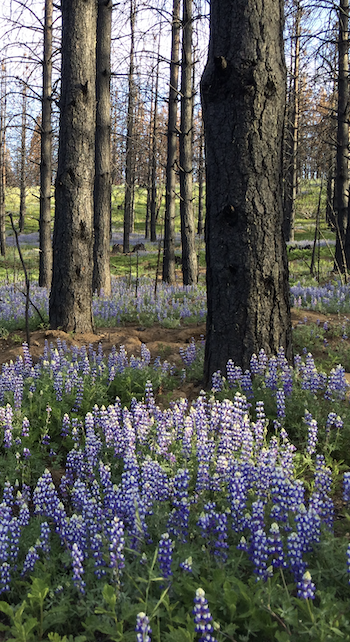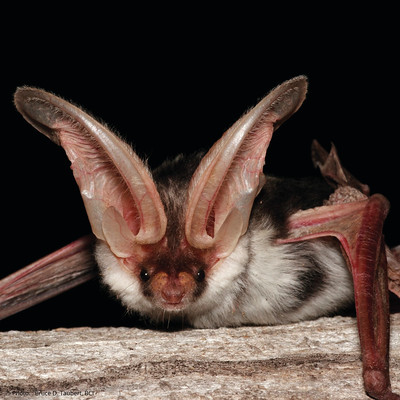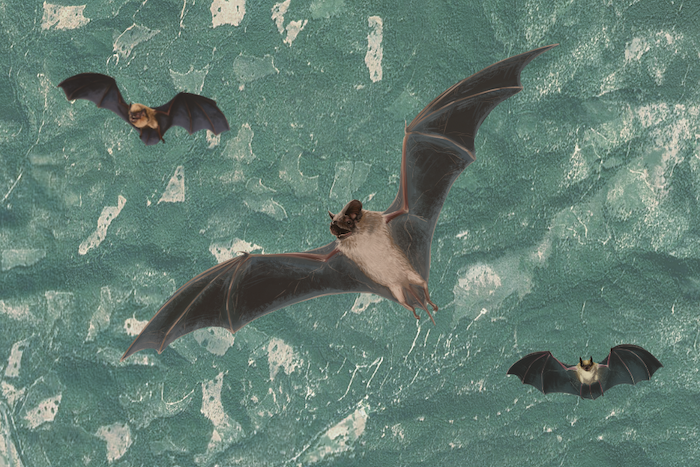In 2019, IBP research associate Dr. Rachel Blakey and colleagues took a close look at the traits and habitats of the 17 bat species that occur in the Sierra Nevada of California. They found that bats, like birds, match their sounds and body shape to their habitat, especially the vegetation structure. This study focused on the habitat immediately around sites where bats were detected. But although bats are some of the smallest mammals in North America, they live life on a larger scale - a landscape scale.
In a recent paper in the journal Landscape Ecology, Blakey and colleagues zoom out and look at how habitat at the landscape scale influences bat species richness. The researchers assessed the presence of different bat species at 83 different sites in the Plumas National Forest in the Sierra Nevada using bat detectors that record the bats’ echolocation calls. (Echolocation calls can be used to identify bats to species just like bird songs are used in bird identification.) At each site they looked at a number of habitat variables such as vegetation structure, extent of forest cover, and configuration of burned and unburned patches after recent wildfires.

Burned forest provides valuable habitat for many bat species.
First a couple of definitions. “Species richness” is the number of species. In everyday language we might also call this diversity, but scientists use that term differently. In ecology the term “species diversity” to refers to a metric that includes both a measure of the number of species present and the abundance of each species. Because bat detectors are better at detecting the presence or absence of species than at counting individual bats, this study uses species richness rather than diversity.
But what does “landscape level” mean? That’s a bit harder to define. It requires thinking about the animal’s longterm needs. A bat might need a tree to roost in while it sleeps during the day, so that site is essential habitat for the bat, but it’s not all it needs. “When we think of the landscape scale, we go beyond a bat's immediate requirements at the time and place of the sample (e.g. foraging, roosting) and think about what bats might need in the longer term,” Blakey explains. “This might include water sources for both drinking and foraging, a network of roosts to keep up social connections, forest edges that facilitate capture of insects, and commuting habitats that link all of these areas together.”
“Landscape-scale” for a given animal also depends on the mobility and habits of that animal. A garden snail, for instance doesn’t travel much over the course of a day, or even its lifetime. So landscape scale for a snail could be defined in meters. “Bats are diverse and their varying home ranges reflect this, but many bats can fly several kilometers from their roosts nightly,” says Blakey. “This means that defining a landscape scale needs to be in the order of kilometers rather than meters.” In this study, the researchers defined landscape scale using a range of areas- 10 concentric circles of 1-10 km radius around each bat sampling site.
The researchers found that heterogeneous forested landscapes are likely to host a greater number of bat species. In other words, the more variety there was in the landscape, the more species of bats that were found there. This relationship was true whether the looked at a smaller landscape scale (1 km) or the largest scale in this study (10 km.)

A spotted bat, one of the species found in the Plumas National Forest and included in this study. Photo courtesy of Bat Conservation International/Minden Pictures.
In the forests of the Sierra Nevada, wildfires are the primary variety generators. Historically, frequent, smaller fires of varying intensities helped create a mosaic of forest burned at different times and severities, with variable vegetation structure. This fire-induced variation in habitat conditions is known as pyrodiversity. The good news, says Blakey, is that bats seem to be largely resilient to wildfire. But this may not be true for all bat species. “We know from our other work on the Plumas that response to fire varies among species and with burn characteristics, with bats adapted to clutter (bats that like more dense vegetation) more likely to respond negatively to frequent or high severity fires,” she cautions.
But in general, the benefits of pyrodiversity for bat species richness mirror what IBP researchers and colleagues have found about pyrodiversity and birds. A 2016 IBP study showed that pyrodiversity increased bird diversity in California’s montane forests. Pyrodiversity can also benefit individual species. For instance, a 2021 IBP study found that juvenile Black-backed Woodpeckers use the edge between burned and unburned/less-severely burned forest. The edge provides this post-fire specialist species easy access to good foraging habitat (burned) and denser vegetation (unburned/less burned) for cover from predators during a vulnerable stage of life. IBP scientists are now looking at how bird populations have responded to decades of variation in fire history and fire severity across Yosemite, Sequoia, and Kings Canyon National Parks.
Just as bats live their lives on a landscape scale, humans manage forests on these larger scales. The results of this study will help land managers conserve the rich variety of bat species that occur in the Sierra Nevada. According to Blakey, this study demonstrates that large-scale fire suppression is unlikely to benefit bats. “Managing western forests for heterogeneity in the landscape, using methods like indigenous fire stewardship, patchy prescribed burns and managed wildfire, will likely benefit bat communities,” says Blakey. If we want a community of bats that’s a mosaic of shapes and sizes, we need a forest that is a mosaic as well.






